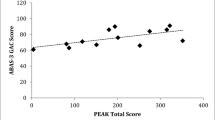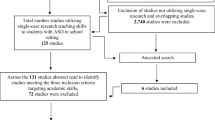Abstract
Objectives
The present study examined the effects of the Promoting the Emergence of Advanced Knowledge (PEAK) curriculum on standardized measures of intelligence and PEAK pre-assessment scores participants with autism spectrum disorders (ASD).
Methods
Direct support staff at a specialized school for students with special needs implemented teaching programs from either the PEAK curriculum (n = 26) or the standard academic curriculum (n = 26) using a randomized control design over one semester.
Results
Statistically significant change scores were observed in raw IQ on two of three sub-scales, vocabulary and information, and full-scale IQ in a sub-group of participants that scored above the floor of the IQ test at either baseline or following intervention. Statistically significant improvements were also observed in PEAK pre-assessment scores in participants in the PEAK group compared to the control group.
Conclusions
Findings indicate that the PEAK curriculum has the potential to positively impact standardized measures of intelligence when implemented for a relatively short period of time by direct support level personnel. These results are especially important given the widespread use of IQ tests to determine placement and eligibility criteria for individuals with special needs.




Similar content being viewed by others
References
Baio, J., Wiggins, L., Christensen, D. L., Maenner, M. J., Daniels, J., Warren, Z., Kurzius-Spencer, M., Zahorodny, W., Robinson Rosenberg, C., White, T., Durkin, M. S., Imm, P., Nikolaou, L., Yeargin-Allsopp, M., Lee, L. C., Harrington, R., Lopez, M., Fitzgerald, R. T., Hewitt, A., Pettygrove, S., et al. (2018). Prevalence of autism spectrum disorder among children aged 8 years - Autism and Developmental Disabilities Monitoring Network, 11 sites, United States, 2014. Morbidity and Mortality Weekly Report. Surveillance Summaries (Washington, D.C. : 2002), 67(6), 1–23. https://doi.org/10.15585/mmwr.ss6706a1
Barnes-Holmes, D., Barnes-Holmes, Y., & Cullinan, V. (2000). Relational frame theory and Skinner’s verbal behavior: A possible synthesis. The Behavior Analyst, 23(1), 69–84. https://doi.org/10.1007/bf03392000
Belisle, J. Rowsey, K. E. & Dixon, M. R. (2016). The use of in situ behavioral skills training to improve staff implementation of the PEAK Relational Training System. Journal of Organizational Behavior Management, 36(1). https://doi.org/10.1080/01608061.2016.1152210
Belisle, J., Dixon, M. R., & Stanley, C. R. (2018). The mediating effects of derived relational responding on the relationship between verbal operant development and IQ. Behavior Analysis in Practice, 11(4), 411–416.
Byington, E., & Felps, W. (2010). Why do IQ scores predict job performance?: An alternative, sociological explanation. Research in Organizational Behavior, 30, 175–202.
Cassidy, S., Roche, B., & Hayes, S. C. (2011). A relational frame training intervention to raise intelligence quotients: A pilot study. The Psychological Record, 61(2), 173–198. https://doi.org/10.1007/BF03395755
Cassidy, S., Roche, B., & O’Hora, D. (2010). Relational frame theory and human intelligence. European Journal of Behavior Analysis, 11(1), 37–51. https://doi.org/10.1080/15021149.2010.11434333
Cassidy, S., Roche, B., Colbert, D., Stewart, I., & Grey, I. M. (2016). A relational frame skills training intervention to increase general intelligence and scholastic aptitude. Learning and Individual Differences, 47, 222–235
Cohen, H., Amerine-Dickens, M., & Smith, T. (2006). Early intensive behavioral treatment: Replication of the UCLA model in a community setting. Journal of Developmental & Behavioral Pediatrics, 27(2), S145
Dixon, M. R. (2014). PEAK relational training system: Direct training module. Carbondale, IL: Shawnee Scientific Press.
Dixon, M. R. (2015). PEAK relational training system: Equivalence module. Carbondale, IL: Shawnee Scientific Press
Dixon, M. R. (2016). PEAK relational training system: Transformation module. Carbondale, IL: Shawnee Scientific Press
Dixon, M. R. (2019). PEAK comprehensive assessment. Carbondale, IL:Shawnee Scientific Press.
Dixon, M. R., Belisle, J., & Stanley, C. R. (2018a). Derived relational responding and intelligence: Assessing the relationship between the PEAK-E pre-assessment and IQ with individuals with autism and related disabilities. The Psychological Record, 68(4), 419–430. https://doi.org/10.1007/s40732-018-0284-1
Dixon, M. R., Belisle, J., Stanley, C. R., & Rowsey, K. (2018b). Student outcomes after 1 year of front line staff implementation of the PEAK curriculum. Behavioral Interventions, 33(2), 185–195. https://doi.org/10.1002/bin.1516.
Dixon, M. R., Paulinas, D., Barron, B. F., Schmick, A. L., & Stanley, C. R. (2019). Randomized controlled trial evaluation of ABA on IQ gains in children with autism. Journal of Behavioral Education. https://doi.org/10.1007/s10864-019-09344-7.
Dixon, M. R., Speelman, R. C., Rowsey, K. E., & Belisle, J. (2016). Derived rule following and transformation of stimulus function in a children’s game: An application of PEAK-E with children with developmental disabilities. Journal of Contextual Behavioral Science, 5, 186–192
Dixon, M. R., Whiting, S. W., Rowsey, K., & Belisle, J. (2014). Assessing the relationship between intelligence and the PEAK Relational Training System. Research in Autism Spectrum Disorders, 8(9), 1208–1213. https://doi.org/10.1007/s10864-015-9219-y
Hayes, S. C., Barnes-Holmes, D., & Roche, B. (2001). Relational frame theory: A post-Skinnerian account of human language and cognition. Springer Science & Business Media
Heyvaert, M., Saenen, L., Campbell, J. M., Maes, B., & Onghena, P. (2014). Efficacy of behavioral interventions for reducing problem behavior in persons with autism: An updated quantitative synthesis of single-subject research. Research in Developmental Disabilities, 35, 2463–2476. https://doi.org/10.1016/j.ridd.2014.06.01
Irwin, C., & Axe, J. B. (2019). Overview of applied behavior analysis and early intervention for autism spectrum disorder. In S. G. Little & A. Akin-Little (Eds.), Behavioral interventions in schools: Evidence-based positive strategies (pp. 205–226). American Psychological Association. https://doi.org/10.1037/0000126-012
Lauderdale-Littin, S., Howell, E., & Blacher, J. (2013). Educational placement for children with autism spectrum disorders in public and non-public school settings: The impact of social skills and behavior problems. Education and Training in Autism and Developmental Disabilities, 48(4), 469–478
Lovaas, O. I. (1987). Behavioral treatment and normal educational and intellectual functioning in young autistic children. Journal of Consulting and Clinical Psychology, 55(1), 3–9. https://doi.org/10.1037/0022-006X.55.1.3
Matson, J. L., & Shoemaker, M. (2009). Intellectual disability and its relationship to autism spectrum disorders. Research in Developmental Disabilities, 30(6), 1107–1114. https://doi.org/10.1016/j.ridd.2009.06.003
May, B. K., & Flake, L. (2019). PEAK pre-assessments: Preliminary evidence establishing internal consistency and construct validity. Behavior Analysis in Practice. https://doi.org/10.1007/s40617-018-00318-1
McKeel, A., Rowsey, K., Dixon, M. R., & Daar, J. H. (2015a). Correlation between PEAK Relational Training System and one-word picture vocabulary tests. Research in Autism Spectrum Disorders, 12, 34–39
McKeel, A., Dixon, M. R., Daar, J. H., Rowsey, K. E., & Szekely, S. (2015b). Evaluating the efficacy of the PEAK relational training system using a randomized control trial of children with autism. Journal of Behavioral Education, 24, 230–241. https://doi.org/10.1007/s10864-015-9219-y
Moore, J. W., Rizer, H. B., Warren, L. K., Yeager, M. G., Brewer, R. R., Barker, L. K., Newborne, B., Russo, K. L., & Potter, M. (2019). An initial evaluation of an assessment method for the PEAK Relational System Direct Training Module. Behavior Analysis in Practice, 13, 126–136. https://doi.org/10.1007/s40617-019-00387-w
Nisbett, R. E., Aronson, J., Blair, C., Dickens, W., Flynn, J., Halpern, D. F., & Turkheimer, E. (2012). Intelligence: new findings and theoretical developments. American Psychologist, 67(2), 130.
O'Hora, D., Peláez, M., Barnes-Holmes, D., Rae, G., Robinson, K., & Chaudhary, T. (2008). Temporal relations and intelligence: Correlating relational performance with performance on the WAIS-III. The Psychological Record, 58, 569–584
Peters-Scheffer, N., Didden, R., Korzilius, H., & Sturmey, P. (2011). A meta-analytic study on the effectiveness of ABA-based early intervention programs for children with autism spectrum disorders. Research in Autism Spectrum Disorders, 5(1), 60–69
Reed, D. D., & Luiselli, J. K. (2016). Promoting the emergence of advanced knowledge: A review of peak relational training system: Direct training module by Mark R. Dixon. Journal of Applied Behavior Analysis, 49, 205–211. https://doi.org/10.1002/jaba.281
Rosenwasser, & Axelrod. (2001). The contributions of applied behavior analysis to the education of people with autism. Behavior Modification, 25(5), 671–677. https://doi.org/10.1177/0145445501255001
Sallows, G. O., Graupner, T. D., & MacLean Jr., W. E. (2005). Intensive behavioral treatment for children with autism: Four-year outcome and predictors. American Journal on Mental Retardation, 110(6), 417–438. https://doi.org/10.1352/0895-8017(2005)110[417:IBTFCW]2.0.CO;2
Sattler, J. M., Dumont, R., & Coalson, D. L. (2016). Assessment of children: WISC-V and WPPSI-IV. Jerome M. Sattler, Publisher, Inc.
Sidman, M. (1971). Reading and auditory-visual equivalences. Journal of Speech & Hearing Research, 14(1), 5–13. https://doi.org/10.1044/jshr.1401.05
Skinner, B. F. (1957). Verbal behavior. Appleton-Century-Crofts
Witts, B. N. (2018). An external review of the conclusions regarding the peak direct training module. Journal of Applied Behavior Analysis, 51, 719–737. https://doi.org/10.1002/jaba.491
Acknowledgements
At the time of this program evaluation, Brandon K. May had no affiliation with Southern Illinois University-Carbondale. The authors thank Mark R. Dixon for his thoughtful comments on an earlier version of the manuscript and SIU graduate students for their assistance in assessment procedures.
Author information
Authors and Affiliations
Contributions
BKM: designed and executed the study, completed the data analyses, and wrote the paper. JS: collaborated in the writing and editing of the final manuscript. All authors approved the final version of the manuscript for submission.
Corresponding author
Ethics declarations
Compliance with Ethical Standards
Informed consent and assent were obtained from all individual participants included in the study.
Human and Animal Rights
All procedures performed in studies involving human participants were in accordance with the ethical standards of the institutional and/or national research committee and with the 1964 Helsinki Declaration and its later amendments or comparable ethical standards.
Conflict of Interest
The authors declare no competing interests.
Additional information
Publisher’s Note
Springer Nature remains neutral with regard to jurisdictional claims in published maps and institutional affiliations.
Rights and permissions
About this article
Cite this article
May, B.K., St. Cyr, J. The Impact of the PEAK Curriculum on Standardized Measures of Intelligence: A Systems Level Randomized Control Trial. Adv Neurodev Disord 5, 245–255 (2021). https://doi.org/10.1007/s41252-021-00199-6
Accepted:
Published:
Issue Date:
DOI: https://doi.org/10.1007/s41252-021-00199-6




